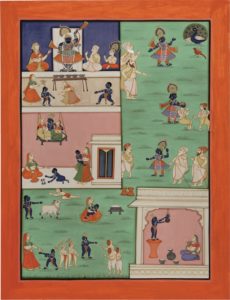Pichvai is the first love of art enthusiast and designer Pooja Singhal. Both hail from the lake city of Udaipur in Rajasthan. Pichvai is luxuriously detailed hand painted textile traditionally hung behind the idol of Shrinathji, an incarnation of Lord Krishna. Over the last century, painted textiles that left the shrine have taken on a new role as wall art and are much sought after by the cognoscenti for their effervescent aesthetics and have spawned a new pursuit among collectors. These days, Pooja is working on her third edition of the Pichvai revival series, Pichvai Tradition & Beyond that opened in Mumbai on April 5 at Famous Studios. This follows the first exhibit in New Delhi in 2015 and special presentation at Kochi Muziris Biennale 2016-2017. Pichvai Tradition & Beyond is a platform designed by Pooja to revive, preserve and sustain the Indian art tradition dating back to the 17th century. She works with artists to further develop this art form in a contemporary context.
In an extensive chat with www.lifeandmore.in, Pooja shares her Pichvai connect and her efforts to revive the art form…
What’s your Pichvai connection?
I belong to a third generation industrialist family with roots in Udaipur. I spent my growing up years there and moved to Modern School Delhi to complete my schooling. I did my Bachelors of Art in Economics from Shri Ram College of Commerce and then pursued my MBA from Katz Business School, Pittsburgh. My interest in the non-profit sector led me to Delhi Crafts Council and Action for Autism. At Delhi Crafts Council, I was exposed to Indian heritage of handloom fabrics and interacted with weavers from different regions and explored Indian crafts. I have always believed there is no revival without commerce and began to work with weavers to modernise handlooms to make them relevant today. I launched Ruh, a brand that specialised in natural and handloom fabrics styled in Indian and Indo-Western silhouettes. Today, Ruh is 14 and a niche brand that uses Khadi, Chanderi, Maheshwari and other natural fabrics as its staple with a small yet expanding retail presence.
My mother has always been a patron of Pichvai and I grew up seeing artists in and out of my home, showing their works to her who would help family and friends visiting Udaipur to buy a good Pichvai. So after Ruh settled, my urge to do something new took me to some of the older Pichvai artists who my mother had supported in the past. Looking at the decline in quality of this art form, I started to research and worked with my team of artists to revive it in its old glory. A long journey and years later, it led to the launch of Pichvai Tradition & Beyond.
My passion for design got me involved with Mumbai-based NGO, Sahachari Foundation, which promotes young designers and raises money for charities they support. I see myself as much a revivalist as an entrepreneur. My passion is to lend commerce to revival and work at preserving our traditional arts and crafts and ensuring they are made relevant for today’s generation.

How difficult was it to bring Pichvai back to the mainstream?
Before my intervention, the Pichvai lineage was on a decline as there was no patronage. Younger generations were finding it difficult to carry out the expense of the materials and hence switched professions. We formed artist ateliers and ensured they receive regular salaries. The shows ensure this art form receives sustenance. Before we did our Jor Bagh show, nobody had seen such a large display of Pichvai works under one roof. Ever since, we have received a phenomenal response not only in India but with international bodies as well.
How do you foresee the future of art in India?
The future of art in India is very bright and is going to be a mix of traditional and contemporary art. I see it like that because traditional art has made a huge comeback and contemporary art is standing on an extremely established ground.
Do art fairs further the cause of art and bring it closer to the common man?
The more events that are around art, there will be larger crowds who will see it. It will create more aspiration and therefore, a larger market and an ability for artists to showcase their work.
In a bid to boost customer and employee engagement, startups and small businesses are reaching out to artists to purchase or subscribe to their paintings. Your reaction to this new trend.
Yes, a new trend has come up and that’s because of larger dissemination of information due to social media and growing aspirations of the Indian community.
Even as Indian art and artists made a mark worldwide, the art market back home reeled under the impact of demonetisation and tax levies. Do you feel it will continue or the dust will settle down anytime soon?
I think the dust is already settling and the art market is a thriving one which has already seen a comeback. We did have a slightly slow period but quickly witnessed a comeback and since then I’ve seen no change in the market for art.